Can you cut 1 Tonne of carbon pollution out of your life?
Take the challengeThe art of making sourdough bread is a delightful exercise in returning to the "olden days" of some of the original DIYers--the gold miners and the pioneers. Sourdough isn't a new, green technology; it's an old, even ancient, technology that has sustained people for milennia. Making our own sourdough returns us to an age of LESS technology and LESS speed. Don't forget: LESS money too!
Sourdough bread, made properly, ambles slowly in a world that frantically runs. It might even ask for a tall glass of sweet tea and a rocking chair on the porch.
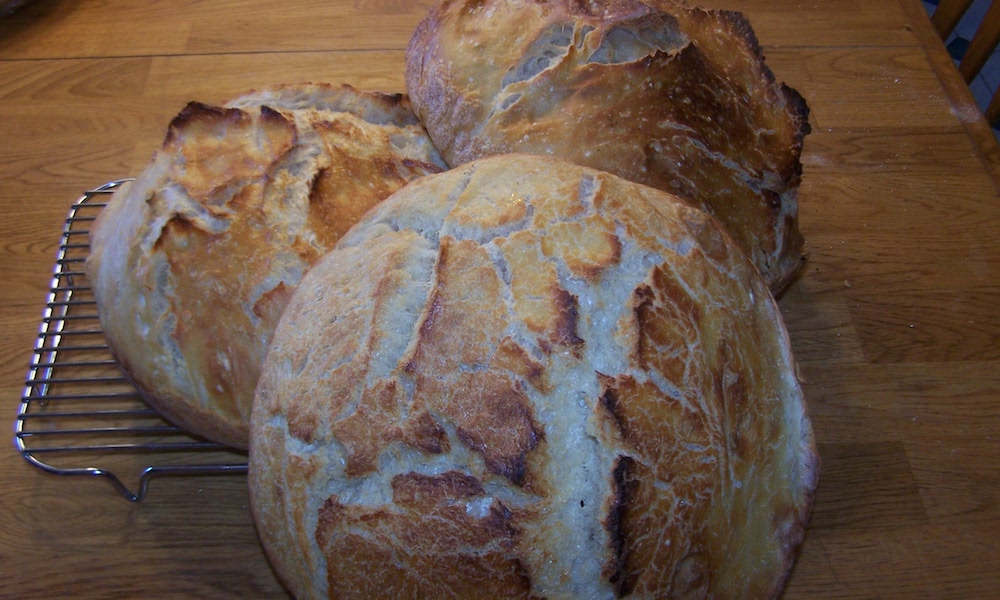
How in the World Does Sourdough Save Energy?
I'm glad you asked!
First of all, any time we prepare our own food instead of buying it at the supermarket, we're choosing a lower tech option.
- We start by saving the fuel cost of driving to the store to buy bread.
- We save the energy cost of the commercial manufacturing process of baking bread.
- We save the fuel costs of shipping commercial bread to stores.
- We know exactly what's IN our bread because we've made it by hand. There are no additives or funky unnatural ingredients.
- Every step of the breadmaking process is done by hand. We don't use mixers or blenders or any power-consuming appliances.
- We can even choose the option of baking our bread in the woodstove, on the charcoal grill, or over a campfire if we want to avoid using the oven.
- Both bread-making and the cultivation of sourdough starters have some great community implications. We're not in this alone. Just like the yeasts in the sourdough, we can permeate our communities with change.
- Best of all, anyone can make this bread. The average individual who is trying to live responsibly, minimize use of non-renewable resources, maximize use of renewable resources, and make small but significant changes can easily start making bread like this.
Sourdough starter itself is a great example on a small scale of a renewable and renewing resource. The crock of starter sitting on the counter can remind you every day that small things make a difference.
So let's get started. This is much more of a method than a recipe. It's not difficult. The entire process takes several hours, but for most of that time, the starter does all the heavy lifting.

Ingredients
- 1 cup sourdough starter*
- 6 cup bread flour**
- 3 cup water
- 2 tsp salt
- 1/4 tsp yeast
*information on sourdough starter is in the next step
** Bread flour works best, but all-purpose flour will also work out just fine. If you want a whole wheat loaf, you can substitute whole wheat flour in a roughly 1 to 1 proportion. I personally find that a loaf made of 100% whole wheat flour, especially flour I grind myself, a little too heavy for my family. Using 50% home-ground whole wheat flour produces a nice loaf. Some of the rise times might need to be adusted if your kitchen is cool.
Method
Step 1: Sourdough starter

If you don't have your own sourdough starter, there are a number of ways to get some.
You can find a friend who makes sourdough or keeps starter. If you start asking around, you might be surprised by how many people have sourdough starter sitting in the back of the fridge. You can buy a little kit of dry ingredients and mix up your own starter. Doing it this way will add some time because you'll need to let the starter get established before you use it.
Or, if you're feeling brave, you can try making your own starter from scratch. Check out here or here.
Step 2: Mix water and starter
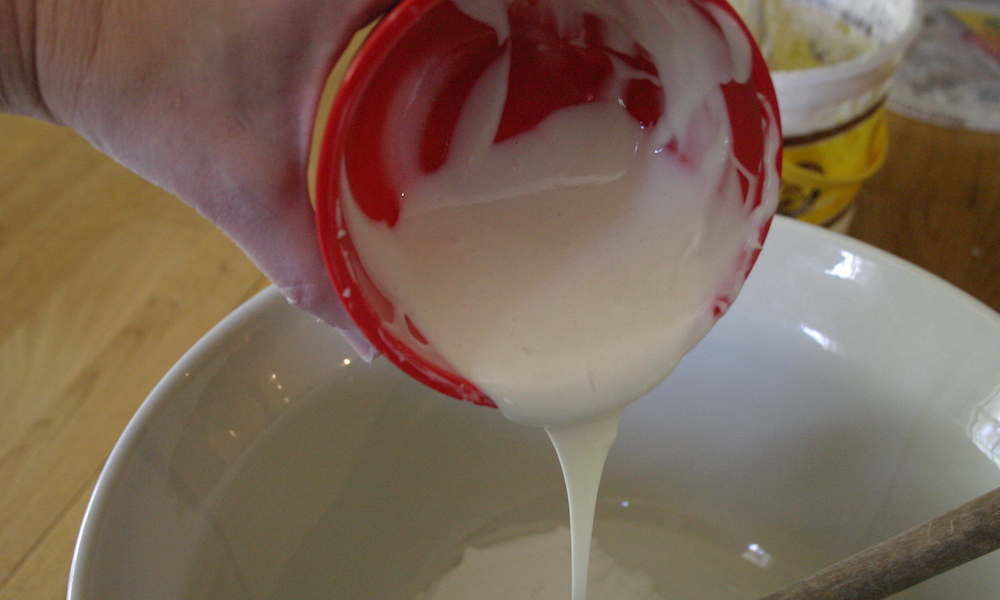
Start by pouring two cups of room temperature tap water (not warm) into a very large bowl. Scoop out 1 c. of sourdough starter and stir it in. The starter likes being stirred up and aerated, so stir or whisk it together vigorously.
Take a moment to replenish your starter right now. If you're making one batch of sourdough and using one cup of starter, replenish with 1/2 c. water and 1 c. flour. If you're making two batches at once (which is what I usually do) you'll replenish the starter with 1 c. water and 2 c. flour. The proportion of water to flour is usually 1 part water to 2 parts flour. If the starter gets too thick or too thin, you can adjust according.
Step 3: Add yeast and flour
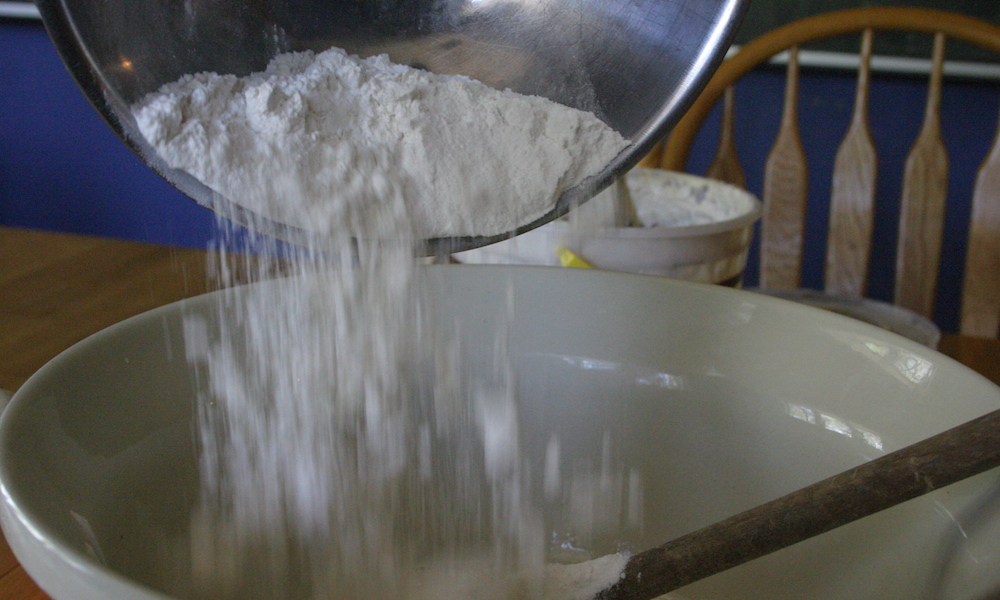
Stir in 1/4 t. yeast and 3 c. bread flour. Mix until smooth.
It's been brought to my attention that I should not need any commercial yeast at all if I'm using yeast-rich sourdough starter. That's true for me in the summer when my kitchen is 85 degrees. In the winter, my ambient kitchen temperature often stays around 55 degrees and I use that 1/4 t. for a little boost. Using only 1/4 t. means that the yeast flavour doesn't dominate the sourdough flavour.
Step 4: Add more water and the salt
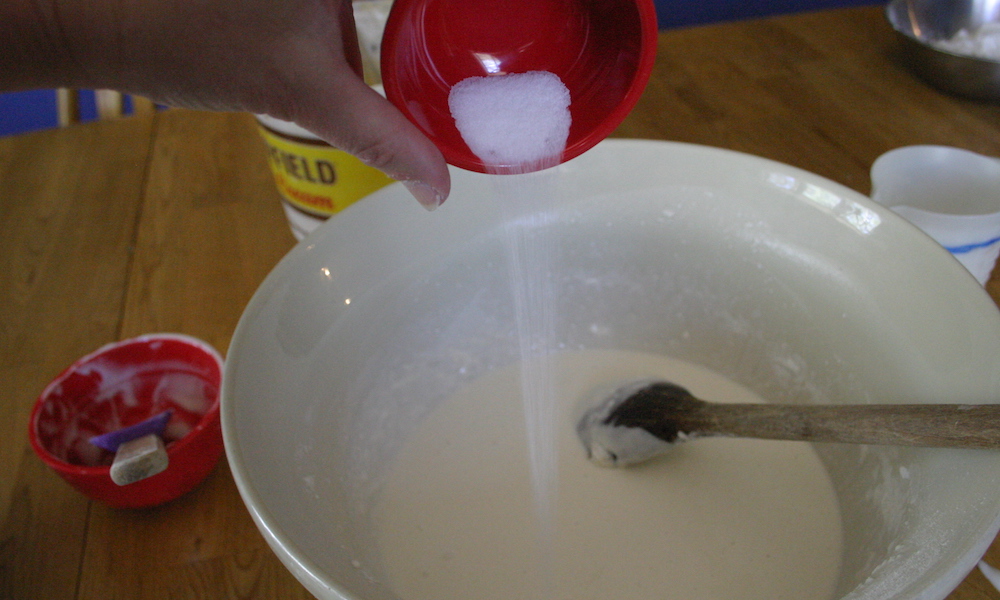
Stir in the 3rd cup of water. Add the salt and mix thoroughly. The salt will slow down the fermentation. This is a good thing. The longer the sourdough takes to rise, the more sour the bread will be. If you're not comfortable with this much salt, you can reduce the amount. It will affect the flavor though, so experiment a little.
Step 5: Add the last of the bread flour
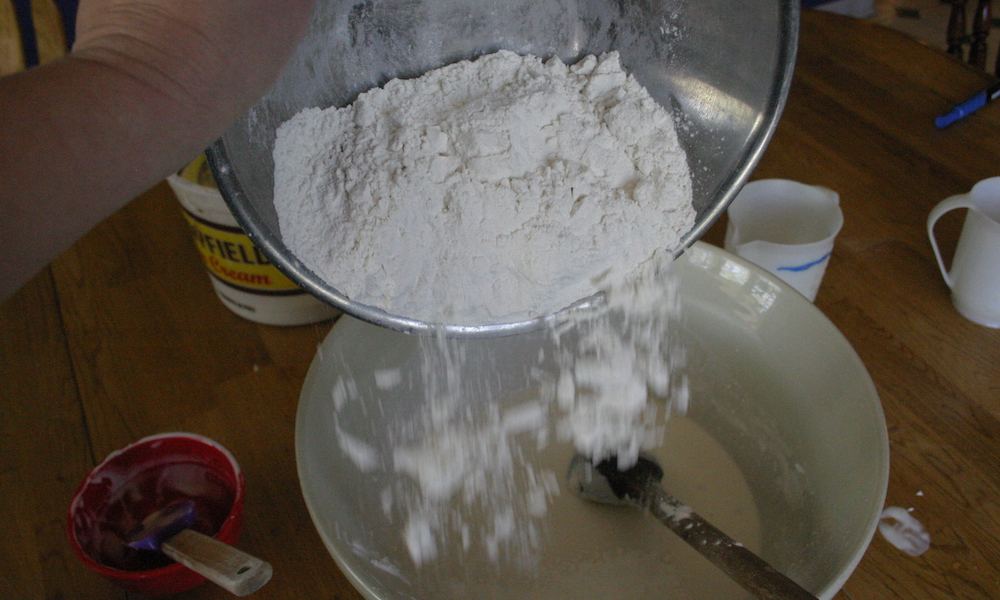
Stir in the remaining 3 c. bread flour. Stir until completely mixed. You do NOT need to knead this bread. The sourdough starter will actually do that for you. All those little yeasts get rowdy and over time inspire gluten fibres to form. This gives the bread its unique sourdough texture.
Step 6: Cover and let the sourdough do its work

Cover the bowl of dough with a towel and set aside in a draft-free place. Don't be jiggling the dough while it's doing its thing. Leave it alone. And then leave it alone some more. The bread dough needs to just sit and do its thing for 12-15 hours. When it's done, the dough will be bubbly and BIGGER than it was at the start. If the bubbles start to pop, then it's gone too long. It doesn't hurt to peek at it from time to time.
Sometimes you can see a little bit of clear liquid accumulating around the edges of the dough. This is actually a by-product of the fermentation process of the sourdough yeasts. The old miners called that hooch!
Now, let me make some disclaimers. First, if your kitchen is particularly warm or this is the middle of the summer, you might need to shorten this first rise time. If you notice the bubbles popping, then the dough ready for the next step. You CAN slow things down by refrigerating the dough at any point.
Step 7: Turn the dough out
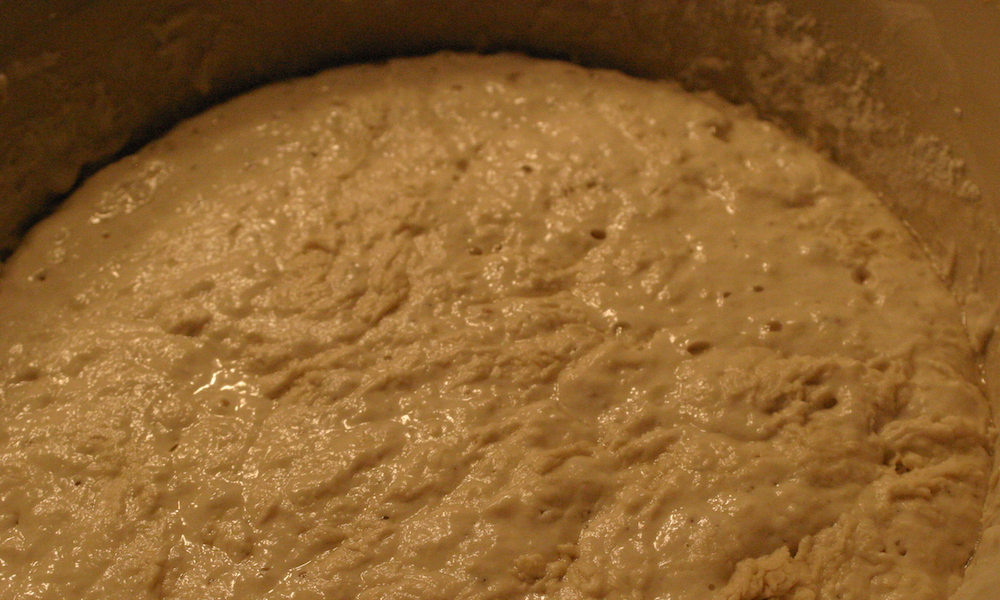
Now it's time for the step that we call "turning out the dough." Start by sprinkling some more flour across the top of the dough. Then plunge your hands into the flour bin and get thoroughly floured up. Start by sweeping your hand around and under the dough in the bowl. Go stick your hand in the flour bin again. Scoop the dough up and over. Get a little more flour on your hands. Scoop and roll the dough over. It shouldn't take too many scoops and sweeps before the dough starts feeling elastic and practically alive! Turn the dough out onto a well-floured surface OR a large piece of plastic wrap that has been sprayed with nonstick spray.

Now comes the less-fun part: washing out the bowl. I use a plastic grocery club card to scrape all the bits of dough off the bowl. After washing and thoroughly rinsing the bowl, dry it completely.
Step 8: Get the dough ready for the second rise

The dough is ready for its second rise. You have two options. You can either oil the inside of the bowl so that the dough will roll out easily when it's time to put it in the oven.
Or, if you're feeling slightly less virtuous and green, you can just put the dough on the plastic wrap into the bowl. The dough will come off the plastic wrap easily because you sprayed a nonstick spray on it, remember?
Step 9: Cover and let the dough REST again
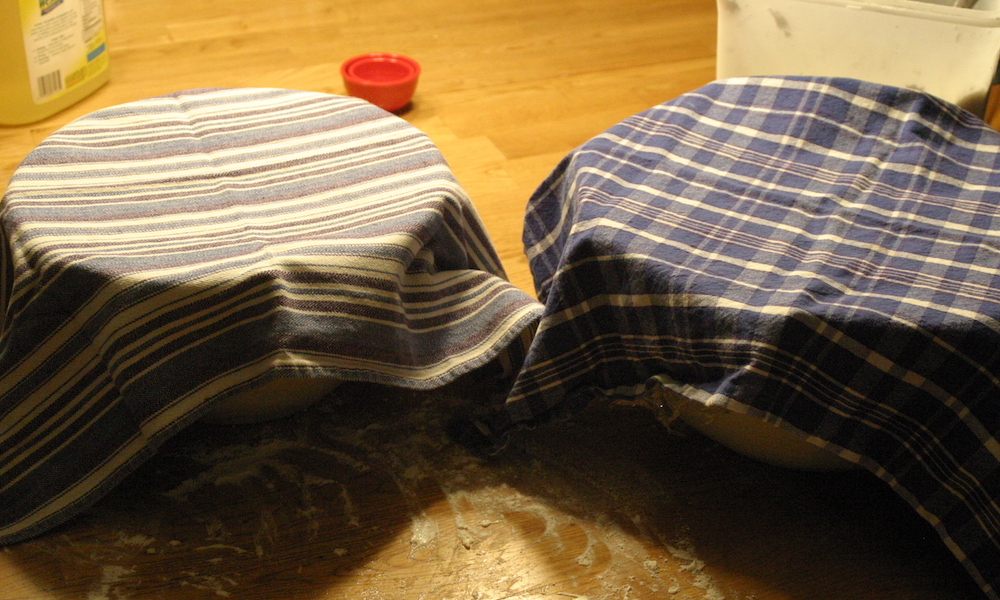
Yes, we're letting the dough rest. The sourdough still has not finished creating gluten fibers, so it needs a few more hours. Cover the bowl with a towel and set in a draft-free area. How long the dough rests will depend a lot on the room temperature. If your kitchen is fairly cool, you should let the dough rest another 4-5 hours. If your kitchen is warm, you'll want to keep an eye on things and consider baking the bread after only 2-3 hours.
Pay attention to the dough during this stage. The thing that you do NOT want is for the starter to consume all the available fuel (flour) in the dough. If that happens, the dough will collapse in on itself after rising. If you see signs of the dough starting to collapse--that means the bubbles are bursting and the centre of the dough begins to sag a little--it's time to hustle that bread into the oven.
Step 10: Preheat the pans
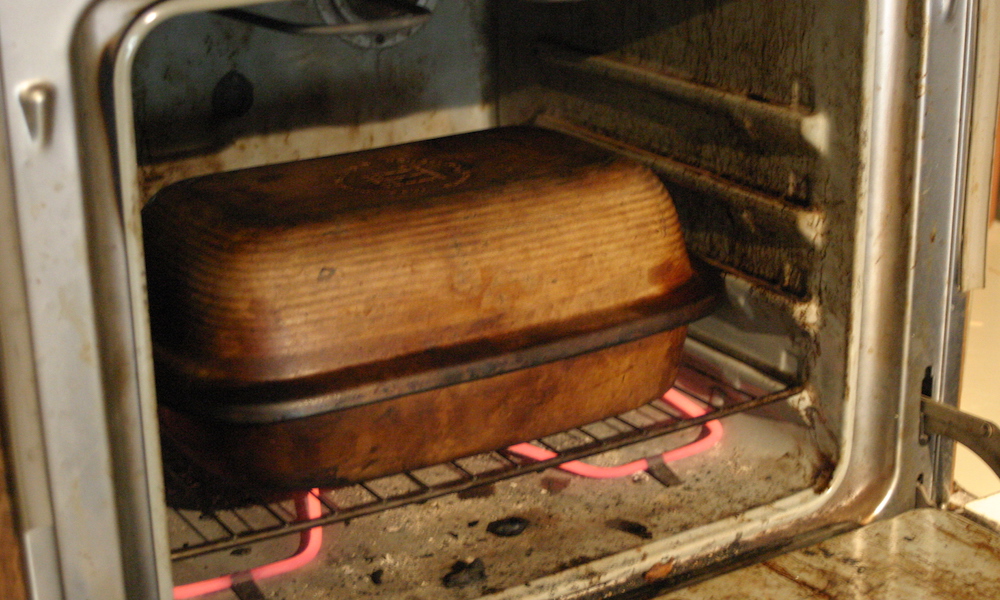
The type of pan you use is actually very important. The very best option is a heavy cast iron dutch oven with a cover. I also use a covered roasting pan made by Pampered Chef that I got from a thrift store for $7.
The key is the cover. You'll need a cover to create a miniature steam oven for the first 30 minutes of baking. I use pans that are 8 - 12 quarts in size. The pan should be at least 8 quarts in size. If you want to divide the bread into two smaller loaves because you only have smaller pans, everything stays the same in terms of baking time.
Another important feature to pay attention to is the sides. The sides of the pan need to be straight or tapering out. If the top of the pan is narrower than the widest part of the pan, don't use that that pan! You'll never get the loaf out.
Pyrex dishes work very well for this method of bread-making with one important caveat. If you set the heated pyrex on a surface with ANY moisture on it at all, the pyrex will explode, sending shards of glass everywhere. I blew up some of my best casserole dishes before I settled on my cast iron.
Turn your oven on to 450 degrees and stick the pan and cover in to preheat for 30 minutes.
Step 11: FINALLY bake the bread

Pull the pan out of the oven, being very careful not to burn yourself. Sprinkle corn grits or oatmeal on the bottom of the pan. This will keep the bread from sticking.
Gently roll the dough out of the bowl and into the pan. Pop the cover back on and put it in the oven. Bake at 450 degrees for 30 minutes.
Then remove the cover and bake for an additional 15 minutes. This will brown up the top of the bread.
After a total of 45 minutes, you'll carefully take the bread out of the oven and tip it out onto a cooling rack.
IF you can resist sneaking a slice right away, you're a far better individual than anyone who lives in MY house.

The very best time to eat any bread is about 30 seconds after it comes out of the oven.
Enjoy!
This recipe originally appeared on Instructables by My Sisters Kitchen.
Read this next: Kale: Tips And Tricks For Growing Your Own
We're in a climate emergency and it's going to take all of us to get out of it. That's why 1 Million Women is building a global community of women committed to fighting climate change with our daily actions. To join the (free) movement just click the button below!
